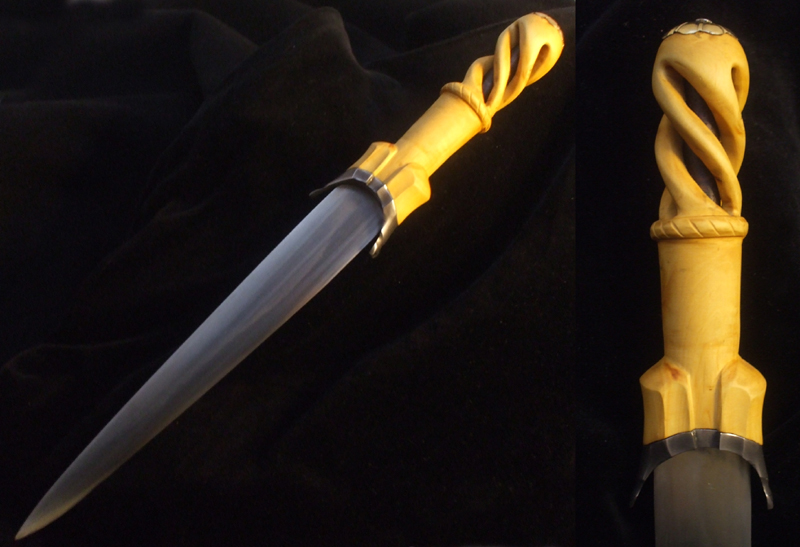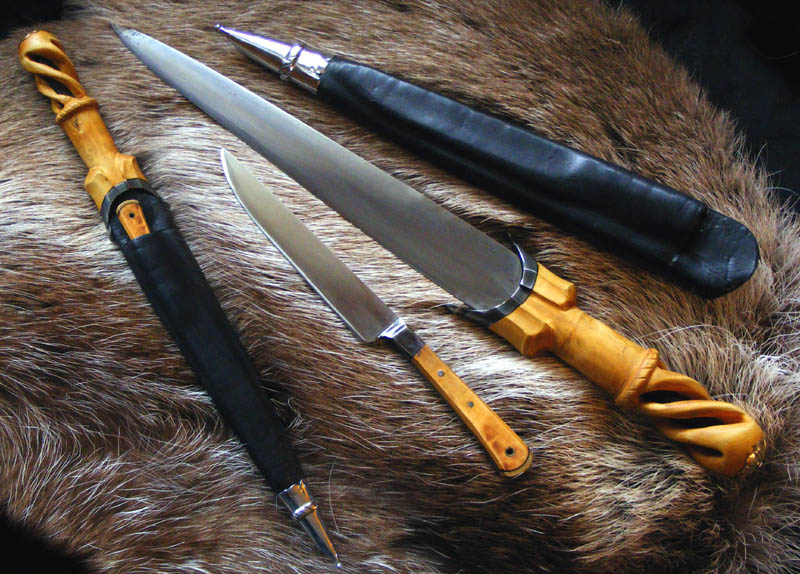| Author |
Message |
|
Fabrice Cognot
Industry Professional
|
 Posted: Wed 30 Nov, 2011 4:07 pm Post subject: A twisted grip ballock dagger Posted: Wed 30 Nov, 2011 4:07 pm Post subject: A twisted grip ballock dagger |
 |
|
Hello all
Another piece that couldn't find an owner earlier this month at the Pontoise market - though I admit it would look more 'complete' with a scabbard, something I'm hoping to get done before year's end.
Measurements are 33.5 cm OAL, the blade is 24.5 cm and 6.5 mm thick at its base.
I opted for a differential heat-treating - also (but not only) to echo the construction found in period blades that associated a hardened, steel edge with a soft, unhardened iron back - the difference being that at that time the steel edge would be welded on the iron back (or core) to save steel as it was considerably more expensive than iron. You can see the wavy line resulting from this differential hardening process on the blade.
The main inspiration for the handle was this piece :
http://collection.musenor.com/application/mot...vre=394721
..currently kept in the Hôtel Sandelin Museum in Saint Omer, France. The original had a copper tube inside a bone handle, but I preferred boxwood over the latter as it was at the time more readily available to me. Besides, other dagger showing a similar construction or shape use different types of wood for their handles.
The inside tube was made of carefully hand-turned walnut wood that would closely fit in the boxwood handle. Making the twisted part was a time-consuming process I must say, but full of lessons.
The guard was hand-forged and then filed to shape in mild steel, then given a surface treatment resulting in a nice, dark patina.
The Saint Omer dagger also had a two-edged blade, but ballock daggers of a similar type show variations in terms of blade shapes so associating it with a single-edged blade didn't look like nonsense (your bview might vary on that).
The end cap is brass, hammered and filed to shape.
I'll post more pics when the scabbard is finished. Although I'm hesitating on either giving it a simple, smooth, plain appearance or instead to go for a fancily decorated sheath that would match the handle...and what of a by-knife ? ...Ah, dilemmas, questions, torture for my poor brain....
Anyway : still available.
Cheers
Fab
 Attachment: 249.12 KB Attachment: 249.12 KB

PhD in medieval archeology.
HEMAC member
De Taille et d'Estoc director
Maker of high quality historical-inspired pieces.
|
|
   |
 |
Christopher Gregg

|
 Posted: Wed 30 Nov, 2011 4:48 pm Post subject: Posted: Wed 30 Nov, 2011 4:48 pm Post subject: |
 |
|
Fabrice, that is a beautiful dagger! I like the wood inside other wood treatment - it catches the eye nicely.
Christopher Gregg
'S Rioghal Mo Dhream!
|
|
  |
 |
|
Colt Reeves
|
 Posted: Thu 01 Dec, 2011 12:05 am Post subject: Posted: Thu 01 Dec, 2011 12:05 am Post subject: |
 |
|
Interesting. Do you think it'll get dirty in there or be a pain to clean?
"Tears are for the craven, prayers are for the clown.
Halters for the silly neck that cannot keep a crown.
As my loss is grievous, so my hope is small.
For Iron, Cold Iron, must be master of men all..."
-Cold Iron, Rudyard Kipling
|
|
  |
 |
Daniel Wallace

|
 Posted: Thu 01 Dec, 2011 3:19 pm Post subject: Posted: Thu 01 Dec, 2011 3:19 pm Post subject: |
 |
|
now that is very different. i thought about inlaying one wood into another to give a different look on some of my knives, but this takes it to another level. it just goes to show you that there's still so much on period material that we can be endlessly reinspired from.
i always enjoy seeing imaginative wooden grips over leather. true that tooled leather can be worked into great stuff, but i just see wood as having nearly endless possibilities.
|
|
  |
 |
|
Fabrice Cognot
Industry Professional
|
|
   |
 |
|
Fabrice Cognot
Industry Professional
|
 Posted: Fri 09 Dec, 2011 1:01 am Post subject: Posted: Fri 09 Dec, 2011 1:01 am Post subject: |
 |
|
I'm currently working on a scabbard for this dagger - and also on a by-knife, incidentally.
For a dagger of similar overall shape (although with slightly diffeent details) and twisted handle construction appears on the second panel of the diptych (originally planned as a quadriptych BTW) of The Justice of Emperor Otto, by Dieric Bouts, currently kept in Brussels :

Take a look at the man in black behind the Emperor's throne. There seems to be a light detail near the top of the scabbard, that can't be a metallic throat as there's a black pace between the dagger's guard and this light grey spot.
I indentify it as part of the grip of a by-knife kept inside a secondary sheath...and the temptation was too great not to ad this feature to this dagger I made. So it is still a work in progress, in a way. But I hope to have it finished before Christmas. And, before that, if any of my friends near Brussels would be kind enough to provide me with a close-up pic of this dagger, that would be immensely appreciated.
This painting also gives us a cleared date for this dagger, as Bouts died in 1475 and began working on these panels after 1464.
PhD in medieval archeology.
HEMAC member
De Taille et d'Estoc director
Maker of high quality historical-inspired pieces.
|
|
   |
 |
|
Fabrice Cognot
Industry Professional
|
 Posted: Wed 04 Dec, 2013 8:52 am Post subject: Posted: Wed 04 Dec, 2013 8:52 am Post subject: |
 |
|
I finally managed to give this dagger a scabard and by-knife - the latter is high carbon steel, with boxwood scales, and steel & brass rivets (the tubular brass rivet being made from a hand-rolled sheet, as seen on period examples).
Said knife is 183 mm long, with a 105 mm blade.
Scabbard is natural-dyed, vegetable-tanned leather, hand-worked, glued on a poplar core with hide glue (that I prepared myself). Scabbard end is mild steel.
 Attachment: 143.7 KB Attachment: 143.7 KB

PhD in medieval archeology.
HEMAC member
De Taille et d'Estoc director
Maker of high quality historical-inspired pieces.
|
|
   |
 |
|
Fabrice Cognot
Industry Professional
|
|
   |
 |
|
Matthew Stagmer
Industry Professional
|
 Posted: Wed 04 Dec, 2013 1:43 pm Post subject: Posted: Wed 04 Dec, 2013 1:43 pm Post subject: |
 |
|
Once agian! Fantastic work!
Matthew Stagmer
Maker of custom and production weaponry
Youtube.com/ThatWorks
|
|
   |
 |
|
Patrick Kelly
|
 Posted: Wed 04 Dec, 2013 5:00 pm Post subject: Posted: Wed 04 Dec, 2013 5:00 pm Post subject: |
 |
|
Fabrice, that's a great piece. An unusual design for the modern market, but beautiful and unique. I love the addition of the by-knife. Quite high on the coolness scale.
"In valor there is hope.".................. Tacitus
|
|
   |
 |
|
Philip Melhop
|
 Posted: Thu 05 Dec, 2013 7:02 am Post subject: dagger and by knife Posted: Thu 05 Dec, 2013 7:02 am Post subject: dagger and by knife |
 |
|
Hi Fabrice, nice looking dagger, please PM me the details and price.
Phil
|
|
  |
 |
Julien M

|
 Posted: Fri 06 Dec, 2013 2:51 am Post subject: Posted: Fri 06 Dec, 2013 2:51 am Post subject: |
 |
|
I took my time to look at this piece closely at Pontoise. It is really unique and Fabrice work is very true to form and as close as it gets to a real medieval artefact.
Great work and looking to see more of that soon!
Julien
|
|
  |
 |
Jean Thibodeau

|
 Posted: Fri 06 Dec, 2013 3:50 am Post subject: Posted: Fri 06 Dec, 2013 3:50 am Post subject: |
 |
|
Fabrice, firstly I love the aesthetics of this knife and as others have said your work always looks like you had a time machine and went back in time to buy the work from a period top maker.
Only, one question due to only my personal obsession for robust construction and avoiding any weak points in a design can could be too easy to break: The very deep carving of the handle, I just wonder if this might make the handle " theoretically " more fragile than if the carving was less deep ?
Depending on material this could easily be a " non-issue ": Boxwood I think is very strong, and if not easy to split along the grain probably still stronger than needed.
Well, if abused by using the dagger as a throwing knife ( Not likely, or smart, today or even in period ) it might be damaged if it hit something hard with the handle where the carving is very deep.
This is really a design and structural strength question that I'm asking out of curiosity as I don't think that this weakens the handle in normal use unless something extreme was done with the knife or if one dropped the knife from a great height onto a hard surface ..... in such a case even a smooth and solid handle would get at least some cosmetic damage.
You can easily give up your freedom. You have to fight hard to get it back!
|
|
  |
 |
|
Fabrice Cognot
Industry Professional
|
 Posted: Fri 06 Dec, 2013 10:01 am Post subject: Posted: Fri 06 Dec, 2013 10:01 am Post subject: |
 |
|
Hi Jean
I don't think such a design would make the dagger any more fragile ; as you said, boxwood is very robust, being a tight grained wood, but in addition to that the chestnut wood core is here to provide some backing to the handle - the St Omer original sports a copper tube, apparently.
Also, the main grip is located somehow closer to the guard, or at least the middle part of the handle, so there's not that much strain put on this part of the dagger.
There is some ballock dagger throwing in Talhoffer, though 
And thanks for the kind words (and to all of you BTW). You honour me.
PhD in medieval archeology.
HEMAC member
De Taille et d'Estoc director
Maker of high quality historical-inspired pieces.
|
|
   |
 |
|
|

